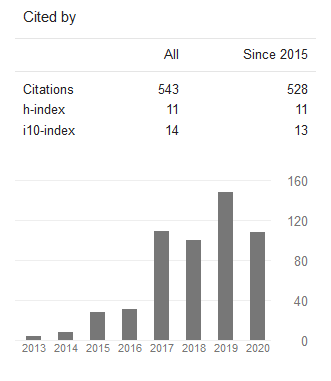SISTEM CERDAS PENDUGAAN SALINITAS AIR LAUT BERDASARKAN CITRA LANDSAT MENGGUNAKAN METODE Adaptive Neuro Fuzzy Inference System ( ANFIS )
DOI:
https://doi.org/10.24002/jbi.v9i1.1283Abstract
Abstract. The purpose of this research is to predict the sea surfce salinity, so that it can be used as refractory material for salt production. Salinity is the soluble salt content in water and the suitable the salinity standard in salt industry will give an impact on the quality of the salt produced. The method of this research is Adaptive Neuro Fuzzy Inference System (ANFIS). The system in this research works by extracting landsat 8 image to produce some value variable which is used as dataset in ANFIS system such as red , green, blue, Longitude and Latitude value. Its dataset will be divided to training and testing data. Training data is used to train the ANFIS system while testing data is used to measure the prediction accuracy resulted by ANFIS. in order to know the level of accuracy by using Root Means Square Error ( RMSE ) method is used to measure the accuracy level. The system has been able to make predictions with error rate of 2,0267 in average.
Keywords: Salinity, Landsat Image, Smart System, ANFIS.
Abstrak. Penelitian ini bertujuan untuk memprediksi salinitas air laut yang bisa dijadikan sebagai bahan refrensi untuk produksi garam. Salinitas adalah kadar garam terlarut dalam air, dengan salinitas yang sesuai standart dalam industri garam akan berdampak pada kualitas garam yang dihasilkan. Metode yang digunakan dalam penelitian ini adalah Adaptive Neuro Fuzzy Inference System ( ANFIS ). Sistem kerja dalam penelitian ini dengan mengekstraksi citra landsat 8 sehingga menghasilkan beberapa variabel yang dijadikan sebagai dataset dalam sistem ANFIS diantaranya adalah variabel red, green, blue, Longitude dan Latitude. Dataset tersebut akan dibagi menjadi data Training dan data Testing. Data Training digunakan untuk melatih sistem ANFIS sedangkan data Testing digunakan untuk mengukur akurasi prediksi yang dihasilkan oleh ANFIS. Pengukuran tingkat akurasi menggunakan metode Root Means Square Error ( RMSE ). Sistem yang dibuat telah mampu melakukan prediksi dengan tingkat error rata – rata 2,0267.
Kata Kunci: Salinitas, Citra Landsat, Sistem Cerdas, ANFIS.
References
Asfaw, E., Suryabhagavan, K. V, & Argaw, M. (2016). Soil salinity modeling and mapping using remote sensing and GIS : The case of Wonji sugar cane irrigation farm , Ethiopia. Journal of the Saudi Society of Agricultural Sciences, 23, 2–9. https://doi.org/10.1016/j.jssas.2016.05.003
Dewi, S. dewi, & Hartatik, S. (2006). Neuro Fuzzy integrasi Sistem Fuzzy dan Jaringan Syaraf Tiruan (pp. 22–29). Jojakarta: Graha Ilmu.
Fahnestock, M., Scambos, T., Moon, T., Gardner, A., Haran, T., & Klinger, M. (2016). Rapid large-area mapping of ice fl ow using Landsat 8. Remote Sensing of Environment, 185, 84– 94. https://doi.org/10.1016/j.rse.2015.11.023
Gorji, T., Tanik, A., & Sertel, E. (2015). Soil Salinity Prediction, Monitoring and Mapping Using Modern Technologies. World Multidisciplinary Earth Sciences Symposium, WMESS 2015, 15, 507–512. https://doi.org/10.1016/j.proeps.2015.08.062
Mathur, N., Glesk, I., & Buis, A. (2016). Comparison of adaptive neuro-fuzzy inference system ( ANFIS ) and Gaussian processes for machine learning ( GPML ) algorithms for the prediction of skin temperature in lower limb prostheses. Medical Engineering and Physics, 38(10), 1083–1089. https://doi.org/10.1016/j.medengphy.2016.07.003
Maulana, R. (2012). Prediksi Curah Hujan dan Debit Menggunakan Metode Adaptive Neuro- Fuzzy Inference System (ANFIS). Program Studi Meteorologi Institut Teknologi Bandung, 41, 1–10.
Nafizah, Muhamad, L., & Winarso, G. (2016). Evaluasi Algoritma Wouthuyzen dan Son untuk Pendugaan Sea Surface Salinity (SSS) (Studi Kasus: Perairan Utara Pamekasan). Jurnal Teknik ITS, 5(2), 176–180.
Nuarsa, I. W. (2014). Penggunaan Citra Landsat 8 untuk estimasi Kadar Khlorofil dan Hasil Tanaman PAdi. Jurnal on Agricultural Sciences, 4(1), 37–45.
Sari, V. D., & Sukoja, bangun M. (2012). ANALISA ESTIMASI PRODUKSI PADI BERDASARKAN FASE TUMBUH DAN MODEL PERAMALAN AUTOREGRESSIVE INTEGRATED MOVING AVERAGE (ARIMA) MENGGUNAKAN CITRA SATELIT LANDSAT 8 (STUDI KASUS: KABUPATEN BOJONEGORO). Teknik Geomatika, Institut Teknologi Sepuluh Nopember, 8, 194–203.
Schroeder, W., Oliva, P., Giglio, L., Quayle, B., Lorenz, E., & Morelli, F. (2016). Active fi re detection using Landsat-8 / OLI data. Remote Sensing of Environment, 185, 210–220. https://doi.org/10.1016/j.rse.2015.08.032
Walid, M., Suprapto, Y. K., & Zaini, A. (2014). Noise Detection OnTheTemple Relief Images Using Adaptive Neuro Fuzzy Inference System. ISITIA 2014, 3, 214–223.
Wouthuyzen, S., Tarigan, S., Kusmanto, E., Supriyadi, H. I., & Sediadi, A. (2011). MEASURING SEA SURFACE SALINITY OF THE JAKARTA BAY USING REMOTELY SENSED OF OCEAN COLOR DATA ACQUIRED BY MODIS SENSOR. Mar. Res. Indonesia, 36(2), 51–70.
Yani, A. (2012). Penerapan anfis untuk pengenalan sinyal ekg. SAINTIKOM, 11(2), 93–100.
Zewdu, S., Suryabhagavan, K. V, & Balakrishnan, M. (2017). Geo-spatial approach for soil salinity mapping in Sego Irrigation Farm , South Ethiopia. Journal of the Saudi Society of Agricultural Sciences, 16(1), 16–24. https://doi.org/10.1016/j.jssas.2014.12.003
Downloads
Published
Issue
Section
License
Copyright of this journal is assigned to Jurnal Buana Informatika as the journal publisher by the knowledge of author, whilst the moral right of the publication belongs to author. Every printed and electronic publications are open access for educational purposes, research, and library. The editorial board is not responsible for copyright violation to the other than them aims mentioned before. The reproduction of any part of this journal (printed or online) will be allowed only with a written permission from Jurnal Buana Informatika.
This work is licensed under a Creative Commons Attribution-ShareAlike 4.0 International License.









